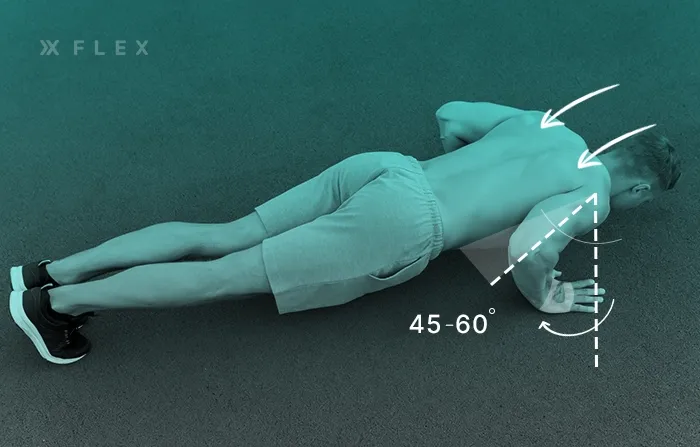Is it Safe to Do 500 Push-Ups a Day?
This is a guide to perfect push-ups. Find out whether doing 500 push-ups a day is safe or effective for building muscle and getting stronger.
Did you know that NFL legend Herschel Walker was known for doing 1,000+ daily push-ups?
This may sound extreme.
But doing mass amounts of push-ups, sit-ups, or bodyweight exercises seems to be all the rage now.
Guys like David Goggins and Russell Westbrook are known to take breaks from hitting the weight rack, incorporating extensive push-up routines into their fitness programs instead.
Methods like the Hundred Pushups Training Program are also extremely popular for fitness enthusiasts.
Thousands, though, seem a bit much, even for the most elite athletes. But we’re starting a bit more low-key here. We’re going for 500 push-up reps per day.
Is it possible to do 500 push-ups per day safely? 200 push-ups a day? What’s the safe limit for effective push-ups?
Let’s break down what impact doing 500 push-ups a day has on your body.
How to Do Proper Push-Ups

Before you go about incorporating push-ups, let alone 500 of them daily into your training, let’s look at some techniques.
Maybe you’ve been doing push-ups for years. Maybe you’re just getting involved in a calisthenics workout program and are looking for some simple bodyweight exercises to try before you progress to moves like the full planche or muscle up.
There are a few specifics you should get to know when you’re learning how to do a proper push-up.
Unfortunately, it’s easy to get it wrong when it comes to performing perfect push-ups.
Push-ups are a fundamental bodyweight exercise that targets multiple muscle groups in your upper body. To perform them properly, you lower and raise your body with your arms. If you do them right, push-ups can build your strength, endurance ability, and muscle definition.
Seems simple, right? But if you’re working with bad alignment, it’s easy to injure yourself during push-ups.
For example, you can hurt your shoulders if your elbows stick out too far from your sides or too high when you lower your body to the ground.
Let’s walk through how to do a proper push-up.
- Start in a plank position with your hands slightly wider than shoulder-width apart.
- Your body should form a straight line from head to heels, with fully extended arms.
- Bend your elbows and lower your body toward the ground.
- Be sure to keep the elbows pointing backwards as you do this. This will help you prevent shoulder injuries.
- Make sure to hold your body straight. Don’t let your hips sag below the rest of your body or stick your butt up in the air. Doing either takes away from your core engagement.
- Lower yourself until your chest is just above or lightly touches the ground.
- Here, your elbows should be at 90 degrees.
- Push through the palms of your hands to extend your arms and bring your body back to the starting position using your strength.
- Keep your body straight throughout the movement.
- Repeat for as many reps as you need.
What Muscles Do Push-Ups Work?
What makes push-ups so important? These are considered a building block of great fitness, namely because they target so many major muscle groups at once.
Besides the bench press, push-ups are one of the most effective ways to build a strong chest. If you prefer full-body workouts that don't use free weights, push-ups are a great alternative to weight training, when part of a varied workout routine.
These are the key muscles that push-ups work.
Chest
The chest muscles, aka pecs, engage heavily during push-ups, especially as you push your body upwards from the ground.
Shoulders
The front part of your shoulder (anterior deltoid muscle) helps you move your body up and down and keep it stable.
Triceps
These muscles on the backs of your arms extend your elbows and help raise your body once you come to the lowered position of your push-up.
Back
The lats and upper back keep you stable during your push-ups.
Serratus Anterior
The serratus anterior muscles sit on the sides of your ribs and stabilize your shoulder blades (scapulae).
Abdominals
Your abs and core muscles need to be engaged so your body stays stable. These muscles help you keep a straight line from your head to your heels. The abdominal area also connects your upper body to your lower body, so your legs can help play a role in stabilizing too.
Legs
Push-ups aren’t really a lower-body move. That being said, your leg muscles (quadriceps, hamstrings, and calves) do help you stay up above the ground. Engaging your legs also helps you maintain a straight line with your body.
Can you do 500 Push-Ups a Day?
Is it possible to add 500 push-ups to your daily exercise routine?
For some people, it is physically possible to do this many push-ups daily. However, it requires a lot of mental and physical strength.
Many people struggle with push-ups, but they do come easier for certain people.
Men, for instance, generally find push-ups a lot easier than women do, according to scientific research. This is because men tend to have higher centers of mass and carry more strength in the upper body.
That being said, it’s a good idea for women to do push-ups too. Push-ups cause women to experience greater muscular stress, which can be a good thing when starting up a new type of resistance training program.
Is it Healthy to Do 500 Push-Ups a Day?
Short answer: it’s a hard “maybe.”
As we mentioned, your capacity for push-ups depends on your prior training and conditioning, arm strength, genetic factors and many other elements.
That being said, doing a moderately high amount of push-ups has been linked to positive health outcomes.
A Harvard study from 2019 found that adult men who were able to perform at least 40 push-ups in one set were less likely to experience cardiovascular disease in 10 years following the study trial.
This would indicate that performing push-ups for reps is healthy. But what happens when you overdo it? Read on to learn about the safety implications of performing 500 push-ups a day.
Is it Safe to Do 500 Push-Ups a Day?
Although theoretically, it could be safe for some highly trained individuals to do 500 push-ups a day, it is not recommended for most people.
Repetitive push-ups or repetitive anything can put a lot of wear and tear on the joints involved in that movement.
There are several different risks associated with doing 500 push-ups a day. Let’s look at a few of them.
You Will Get Sore
Although it’s an impressive challenge to your body, too many push-up reps will cause your muscles to get very sore.
If you are attempting to do an increased amount of push-ups, it’s important to take time for strategic recovery.
Always remember to stretch after performing any form of physical exercise. It can be a good idea to ice your muscles or try foam rolling after very strenuous workouts.
If you’re having muscle pain or excessive soreness, always consult with a personal trainer or fitness professional. Remember, you can’t train to your maximum capacity if you’re injured.
Putting a lot of work on one muscle or muscle group can lead to overuse or cause repetitive strains.
Overuse injuries can affect your muscles, tendons, bones or ligaments. If you really overdo it, you may be forced to skip the gym for a while. That takes away from valuable training time that you could have been spending on improving your fitness.
Better, then, to just spend a bit of time on smart recovery rather than hurting yourself or straining your muscles.
Overtraining
Too much exercise (in any capacity, not just push-ups) can lead you to tucker out pretty quickly.
What’s more, you’ll probably soon start to see diminishing returns on your workout investment if you train too much.
If you fail to recover properly after a workout, you’re usually doing more harm than good. And with a higher-impact exercise like push-ups, doing 500 a day gives you no time to recuperate your energy or let the tears in your muscles recover in a healthy way that leads to muscular hypertrophy.
Eventually, overtraining can lead to a formalized condition called Overtraining Syndrome (OTS).
Overtraining Syndrome can lead you to experience chronic inflammation, fatigue, or even depression and hormonal issues.
Although you should feel some sense of being tired and having worked hard after a good workout, you shouldn’t chronically get the sense of “Oh no, I won’t be able to walk tomorrow!”
If you’re always feeling completely shot after a gym session, it’s a good idea to focus on longer rest breaks between sets and stretching after exercise.
Improper Recovery
As mentioned above, the “no days off” mentality gives you well… you guessed it. No days off.
To recover properly, especially after a strenuous workout, your muscles need some downtime.
Proper recovery is essential to building healthy muscle. There are many ways to help with your muscular recovery. Techniques to reduce muscle soreness and damage include things like massage, cryotherapy, foam rolling and muscle scraping.
Remember, how you care for your muscles outside your workouts is just as important as the exercises you do to improve your physique.
Ineffective Muscle Building
Furthermore, cranking out massive amounts of push-ups may not be the best way to put on muscle.
Yes, push-ups can help you build muscle mass, get your heart rate up and even achieve some weight loss when practiced diligently.
But there are far simpler ways to achieve these goals while putting yourself at less risk of injury. For most people, a lower-stress routine with less daunting exercises is more sustainable. Think about it: will you really be able to stick with the 500 push-up days beyond maybe a month?
When training for hypertrophy, studies indicate that other moves like the bench press, even at moderate weight and reps can be just as effective as push-ups.
You may gain bragging rights for doing hundreds or thousands of push-ups, but no, it’s not necessarily a more effective way to train for either hypertrophy or strength.
How many push-ups you do basically comes down to personal preference here.
Although you’ve probably seen tons of “I did 500 push-ups a day for 30 days and here’s what happened” videos, there’s no evidence that you can’t get just as fit doing workouts that are more relaxing, shorter, and compatible with a balanced lifestyle.
How Many Pull-Ups a Day?
Can you do more pull-ups a day than push-ups?
Probably not. For the average person, pull-ups are a much harder move to master than push-ups.
In a pull-up, you need to pull your whole weight up to a bar using just your arm strength. For push-ups, the weight is distributed evenly between your arms and legs, so there are more muscles actively working during the push-up to spread out your effort.
With pull-ups, it’s important to start slow. Focus on a great technique that doesn’t make your shoulders feel like they’re going to jerk out of their sockets.
For newbie gymgoers, even one or two pull-ups using your full weight can be extremely challenging! If you can do pull-ups for reps, aim to do 3 sets of 10-15 (no, you don’t need thousands of reps to get jacked).
Pro tip: If you’re a pull-up pro, put your bicep and tricep strength together and start working on some muscle-up progressions!
Big Picture
In short, the 500 push-ups a day challenge seems more like a YouTuber or influencer fad than something you should be implementing into your daily fitness routine.
Although calisthenics workouts are a great alternative to the gym, it’s simply not healthy for most people to perform high-intensity exercises with a high volume of reps of only one move day in and day out.
No matter what your fitness level, finding a way to strength train where you can take rest days is a better approach to physical activity.
Whether you are doing 500 or 200 pushups a day, making sure to rest is essential. Aim for body weight workout plan that prioritizes rest after tough training sessions.
Push-ups are great compound exercises that hit most body parts, but make sure to do some isolation moves too.
A healthier approach is to adopt a varied workout program. If you love push-ups, you can certainly work them into your training routine at a high rep volume.
But you’re probably not going to see tremendous results in terms of muscle mass or total-body strength if you’re skipping moves like heavy squats and deadlifts.
What’s more, too many push-ups with too little rest can lead to things like muscular fatigue or shoulder joint injuries. You can also simply get bored and start feeling uninspired or too lazy to work out.
Unless you’re being supervised by a trainer or health coach and your 500-push-up-a-day regimen is part of training for a specific event, it’s not the best strategy for most people to adopt long-term.
We’ve made tracking your workouts failproof. Flex offers an all-in-one workout platform to help you learn new exercises, visualize your fitness journey and keep all your PRs in one place.
Get simple, customized fitness plans or introduce a little friendly competition to your fitness community by sharing exercises with your friends. Try it for free through the Flex fitness app.
References:
Alizadeh, S., Rayner, M., Mahmoud, M. M. I., & Behm, D. G. (2020). Push-Ups vs. Bench Press Differences in Repetitions and Muscle Activation between Sexes. Journal of sports science & medicine, 19(2), 289–297.
Aicale, R., Tarantino, D., & Maffulli, N. (2018). Overuse injuries in sport: a comprehensive overview. Journal of orthopaedic surgery and research, 13(1), 309. https://doi.org/10.1186/s13018-018-1017-5
Campos, Y. A. C., Vianna, J. M., Guimarães, M. P., Oliveira, J. L. D., Hernández-Mosqueira, C., da Silva, S. F., & Marchetti, P. H. (2020). Different Shoulder Exercises Affect the Activation of Deltoid Portions in Resistance-Trained Individuals. Journal of human kinetics, 75, 5–14. https://doi.org/10.2478/hukin-2020-0033
Elzanie A, Varacallo M. Anatomy, Shoulder and Upper Limb, Deltoid Muscle. [Updated 2023 May 8]. In: StatPearls [Internet]. Treasure Island (FL): StatPearls Publishing; 2023 Jan-. Available from: https://www.ncbi.nlm.nih.gov/books/NBK537056/
Kikuchi, N., & Nakazato, K. (2017). Low-load bench press and push-up induce similar muscle hypertrophy and strength gain. Journal of Exercise Science & Fitness, 1, 37–42. https://doi.org/10.1016/j.jesf.2017.06.003
Solari F, Burns B. Anatomy, Thorax, Pectoralis Major Major. [Updated 2023 Jul 24]. In: StatPearls [Internet]. Treasure Island (FL): StatPearls Publishing; 2023 Jan-. Available from: https://www.ncbi.nlm.nih.gov/books/NBK525991/
Yang J, Christophi CA, Farioli A, et al. Association Between Push-up Exercise Capacity and Future Cardiovascular Events Among Active Adult Men. JAMA Netw Open. 2019;2(2):e188341. doi:10.1001/jamanetworkopen.2018.8341
Related articles
How to Start Calisthenics: A Guide to Bodyweight Fitness
6-Day Gym Workout Schedule: Maximize Your Fitness
2-Day Split Workout: Your Guide to Efficient Gains


Get fit with Flex
Build muscle & lose weight fast for free.
Available on iPhone + Apple Watch





